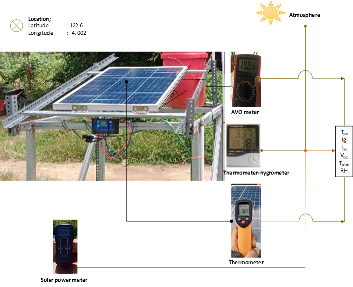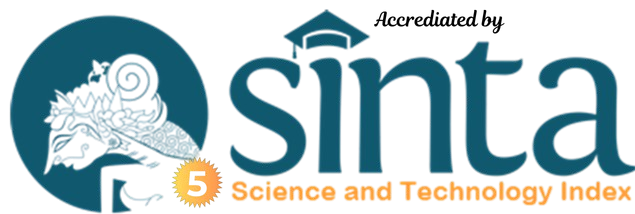Studi Karakteristik Energi Surya untuk Pemanenan Energi: Studi Awal di Kota Kendari
DOI:
https://doi.org/10.55679/pistonjt.v10i1.85Keywords:
Solar energy, Zenith angle, Clearness index, Solar power generation, Kendari cityAbstract
This research aims to evaluate the solar energy characteristics in the Andoonuhu area, Kendari City, Southeast Sulawesi, as a preliminary study for the development of a solar power generation (PLTS). Data collection was conducted using a simulation approach and direct measurements during the period from March to May 2024. The main parameters analyzed include solar radiation intensity, clearness index, zenith, incidence, solar hour angle, and the power output response of the photovoltaic panel SP-50-P36. The study results show that the average daily radiation intensity ranges from 4.5–6.4 kWh/m²/day, with peak energy occurring in May. Analysis of the sun's position on March 23 (equinox) revealed a minimum zenith angle of about 4–5°, indicating near-vertical sunlight conditions relative to the Earth's surface. Solar panels installed at a 15° facing north exhibited relatively small incidence angles during the day, supporting optimal radiation capture performance. Maximum beam radiation was recorded at 12:00 noon, while diffuse radiation contributed more significantly in the morning and evening. The clearness index showed a positive correlation with the solar angle, with optimal values when the elevation angle was above 60°. Panel performance tests revealed a decrease in thermal efficiency due to an increase in module surface temperature up to 49.25°C. This study indicates that the utilization of solar PV energy in Kendari is quite favorable and can be optimized through fixed or tracking system designs. The research provides a technical fundamental data for the development of efficient, sustainable, and adaptive PLTS systems tailored to local radiation characteristics, particularly in the central-eastern region of Indonesia.
Downloads
References
Solargis, “Solar Resource and Photovoltaic Power Potensial of Indonesia,” 2017.
IESR, “Peta jalan mempercepat pensiun pltu batubara pada 2045 (Roadmap to Accelerate the Retirement of Coal-Fired Power Plants at 2045).” Accessed: Dec. 30, 2024. [Online]. Available: https://iesr.or.id/peta-jalan-mempercepat-pensiun-pltu-batubara-pada-2045/
ESDM, Handbook Of Energy & Economic Statistics Of Indonesia 2023. 2023.
D. R. Armanda, “PEMANFAATAN PEMBANGKIT LISTRIK TENAGA SURYA (PLTS) PADA SISTEM KELISTRIKAN SULAWESI UTARA DAN GORONTALO,” Inst. Teknol. PLN, Jakarta, Indones., no. April, 2021.
B. Indonesian Agency for Meteorology, Climatology, and Geophysics), “Dinamika Atmosfer.” Accessed: Jan. 25, 2025. [Online]. Available: https://www.bmkg.go.id/iklim/dinamika-atmosfer
K. E. RI, Sultra Raih Penghargaan Dewan Energi Nasional. 2025.
F. D. Putra, H. Radhiati, L. O. A. Barata, and L. K. Mangalla, “Studi Karakteristik PV Panel sebagai Pemanenan Energi Listrik : Efek Solar Tracking,” Enthalpy J. Ilm. Mhs. Tek. Mesin, vol. 10, no. 1, pp. 1–9, 2025, doi: http://dx.doi.org/10.55679/enthalpy.v9i4 1.
GUBERNUR SULAWESI TENGGARA (South East Sulawesi Governor), RENCANA UMUM ENERGI DAERAH PROVINSI SULAWESI TENGGARA (Regional Energy General Plan). South East Sulawesi, 2021.
L. A. Ningtyas, “Empat Kabupaten di Sultra Terima Bantuan PLTS.” Accessed: Apr. 15, 2025. [Online]. Available: https://www.rri.co.id/daerah/1341460/empat-kabupaten-di-sultra-terima-bantuan-plts
D. G. Erbs, S. A. Klein, and J. A. Duffie, “Estimation of the diffuse radiation fraction for hourly, daily and monthly-average global radiation,” Sol. Energy, vol. 28, no. 4, pp. 293–302, 1982, doi: 10.1016/0038-092X(82)90302-4.
L. C. Nethwadzi and H. Winkler, “Calculation of direct and diffuse solar irradiance components using a Slob Algorithm model in Gauteng conditions,” no. December 2018, 2019.
N. Power, “Reports.” Accessed: Dec. 15, 2024. [Online]. Available: https://power.larc.nasa.gov/data-access-viewer/
www.weatherspark.com, “Average Daily Incident Shortwave Solar Energy in Kendari.” Accessed: Jan. 25, 2025. [Online]. Available: https://weatherspark.com/y/137856/Average-Weather-in-Kendari-Indonesia-Year-Round
M. Aljuwaysir Salah Fahad, K. Osman, U. Abidin, M. S. Ahmad, E. M. H. Ismaeil, and M. U. Farooq, “Review of Cooling Techniques for Improving Solar Photovoltaic Panel Efficiency,” J. Adv. Res. Fluid Mech. Therm. Sci., vol. 125, no. 1, pp. 193–219, 2025, doi: 10.37934/arfmts.125.1.193219.
M. M. Abdel-Aziz and A. A. ElBahloul, “Innovations in improving photovoltaic efficiency: A review of performance enhancement techniques,” Energy Convers. Manag., vol. 327, no. March, p. 119589, Mar. 2025, doi: 10.1016/j.enconman.2025.119589.
Muhammad Iqbal, An Introduction to Solar Radiation. Toronto: Academic Press, 1983. doi: 10.1016/b978-0-12-373750-2.x5001-0.
M. H. Naraghi and E. Atefi, “Optimum Solar Panel Orientation and Performance: A Climatic Data-Driven Metaheuristic Approach,” Energies, vol. 15, no. 2, 2022, doi: 10.3390/en15020624.
J. Ramos and J. A. Valladares, “University of XXX-solar radiation clearness and variability index,” ASEE Annu. Conf. Expo. Conf. Proc., 2014.
S. Himran, Energi Surya: Konversi Termal dan Fotovoltaik (Solar Energi: Thermal Conversion and Photovolataic). ANDI, Yogyakarta, 2021.

Downloads
Published
How to Cite
Issue
Section
License
Copyright (c) 2025 La Ode Ahmad Barata, Samhuddin, Rizqi Firti Naryanto, Mera Kartika Delimayanti, La Baride

This work is licensed under a Creative Commons Attribution 4.0 International License.








